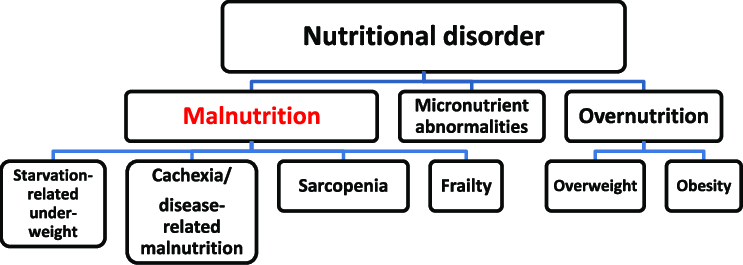Nutritional Disorders by Medical Education, Health Education Gurukul [GOLN]. “Dietary Fiber, Nutritional Disorders” আমাদের আজকের আলোচনার বিষয়। “Dietary Fiber, Nutritional Disorders” ক্লাসটি “এমবিবিএস [ MBBS ]” এর “জৈব রসায়ন [ Biochemistry ]” সাবজেক্ট এর “খাদ্য ও পুষ্টি [ Food & Nutrition ]” অধ্যায়ের পাঠ। “এমবিবিএস [ MBBS ]” এর “জৈব রসায়ন [ Biochemistry ]” সাবজেক্ট এর “Food, Nutrition, Nutrients & Diet” অধ্যায়ের সকল ক্লাস পেতে যুক্ত থাকুন “Medical Education, Health Education Gurukul” এর সাথে।
Nutritional Disorders
some nutrient-deficiency diseases:
Xerophthalmia (vitamin A): blindness from chronic eye infections, poor growth, dryness and keratinization of epithelial tissues liver, fortified milk, sweet potatoes, spinach, greens, carrots, cantaloupe, apricots.
Rickets (vitamin D): weakened bones, bowed legs, other bone deformities fortified milk, fish oils, sun exposure.
Beriberi (thiamin) : nerve degeneration, altered muscle coordination, cardiovascular problems pork, whole and enriched grains, dried beans, sunflower seeds
pellagra’ (niacin) : Diarrhea, skin inflammation, dementia mushrooms, bran, tuna, chicken, beef, peanuts, whole and enriched grains.
Scurvy (vitamin C): Delayed wound healing, internal bleeding, abnormal formation of bones and teeth citrus fruits, strawberries, broccoli.
Iron-deficiency anemia (iron) : decreased work output, reduced growth, increased health risk in pregnancy meat, spinach, seafood, broccoli, peas, bran, whole-grain and enriched breads.
Goiter (iodine): Enlarged thyroid, poor growth in infancy and childhood, possible retardation, cretinism iodized salt, seafood.

Protein-energy malnutrition:Chronic undernutrition manifests primarily as protein-energy malnutrition (PEM), which is that the commonest sort of malnutrition worldwide. Also referred to as protein-calorie malnutrition, PEM may be a continuum during which people—all too often children—consume insufficient protein, energy, or both.
At one end of the continuum is kwashiorkor, characterized by a severe protein deficiency, and at the opposite is marasmus, an absolute food deprivation with grossly inadequate amounts of both energy and protein. An infant with marasmus is extremely underweight and has lost most or all subcutaneous fat. If untreated, marasmus may end in death thanks to starvation or coronary failure .
Kwashiorkor: is usually seen when a toddler is weaned from highprotein breast milk onto a carbohydrate food source with insufficient protein.
Carbohydrates: Long-term carbohydrate inadequacy leads to increased production of organic compounds called ketones (a condition referred to as ketosis), which imparts a particular sweet odour to the breath.

Essential fatty acids :There is additionally a minimum requirement for fat—not for total fat, but just for the fatty acids linolic acid (a so-called omega-6 fatty acid) and omega-3 fatty acid (an omega-3 fatty acid). Deficiencies of those two fatty acids are seen in hospitalized patients fed exclusively with intravenous fluids containing no fat for weeks, patients with medical conditions affecting fat absorption, infants given formulas low in fat, and young children fed nonfat milk or low-fat diets .
Vitamins: Although deficiency diseases are described in laboratory animals and humans bereft of single vitamins, in human experience multiple deficiencies are usually present simultaneously. The eight B-complex vitamins function in coordination in numerous enzyme systems and metabolic pathways; thus, a deficiency of 1 may affect the functioning of others Minerals Etc.

Nutritional Disorders class details:
See also :
